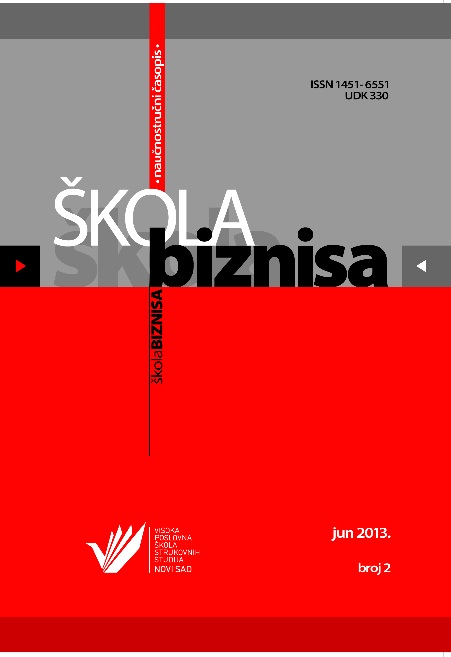EXCHANGE RATE POLICY
Abstract
Small oscillations of exchange rate certainly affect the loss of confidence in the currency (Serbian dinar, CSD) and because of the shallow market even the smallest change in the supply and demand leads to a shift in exchange rate and brings uncertainty. Some economists suggest that the course should be linked to inflation and thus ensure predictable and stable exchange rates. Real exchange rate or slightly depressed exchange rate will encourage the competitiveness of exporters and perhaps ensure the development of new production lines which, in terms of overvalued exchange rate, had no economic justification. Fixed exchange rate will bring lower interest rates, lower risk and lower business uncertainty (uncertainty avoidance), but Serbia will also reduce foreign exchange reserves by following this trend. On the other hand, a completely free exchange rate, would lead to a (real) fall of Serbian currency, which in a certain period would lead to a significant increase in exports, but the consequences for businessmen and citizens with loans pegged to the euro exchange rate, would be disastrous. We will pay special attention to the depreciation of the exchange rate, as it is generally favorable to the export competitiveness of Serbia and, on the other hand, it leads to an increase in debt servicing costs of the government as well as of the private sector. Oscillations of the dinar exchange rate, appreciation and depreciation, sometimes have disastrous consequences on the economy, investors, imports and exports. In subsequent work, we will observe the movement of the dinar exchange rate in Serbia, in the time interval 2009-2012, in order to strike a balance and maintain economic equilibrium. A movement of foreign currencies against the local currency is controlled in the foreign exchange market, so in case economic interests require, The National Bank of Serbia (NBS), on the basis of arbitrary criteria, can intervene in the market.
References
Arsić, M., Mladenović, Z., Nojković, A., & Petrović, P. (2005). Makroekonometrijsko modeliranje privrede Srbije - teorijske osnove i rezultati. Beograd: CES Mecon.
Fondacija za razvoj ekonomske nauke. (2012). Kvartalni monitor ekonomskih trendova i politike Srbije. Preuzeto sa www.fren.org.rs/sites/default/files/qm/5_4.pdf
Fond za razvoj ekonomske nauke. (2007). Kvartalni monitor ekonomskih trendova i politika u Srbiji. Preuzeto sa ceves.org.rs/wp-content/uploads/2012/12/QM8.pdf
Jovović, D. (2011). Dinar i devizni kurs. Beograd: Prometej.
Jovović, D. (2011). Dinar i režim deviznog kursa. Bankarstvo, 40(11-12), 56-81. Preuzeto sa www.ubs-asb.com/Portals/0/Casopis/2011/11_12/UBS-Bankarstvo-11-12-2011-Jovovic.pdf
Kovačević, M. (2010). Uzroci pada i vrlo niskog nivoa konkurentnosti privrede Srbije. Kako povećati konkurentnost privrede i izvoza Srbije. Beograd: Naučno društvo ekonomista Srbije, Ekonomski fakultet.
Milenković, N. (2012). Devizni kurs kao instrument ekonomske politike - iskustva zemalja Istočne Azije. Ekonomski horizonti, 14(3), 139-149. doi:10.5937/ekonhor1203139M
Miljković, D. (2008). Međunarodne finansije. Beograd: Centar za izdavačku delatnost Ekonomskog fakulteta.
Narodna banka Srbije. (2012). Izveštaj o inflaciji.
- Authors retain copyright and grant the journal right of first publication with the work simultaneously licensed under a Creative Commons Attribution License that allows others to share the work with an acknowledgement of the work's authorship and initial publication in this journal.
- Authors are able to enter into separate, additional contractual arrangements for the non-exclusive distribution of the journal's published version of the work (e.g., post it to an institutional repository or publish it in a book), with an acknowledgement of its initial publication in this journal.
- Authors are permitted and encouraged to post their work online (e.g., in institutional repositories or on their website) prior to and during the submission process, as it can lead to productive exchanges, as well as earlier and greater citation of published work (See The Effect of Open Access).

